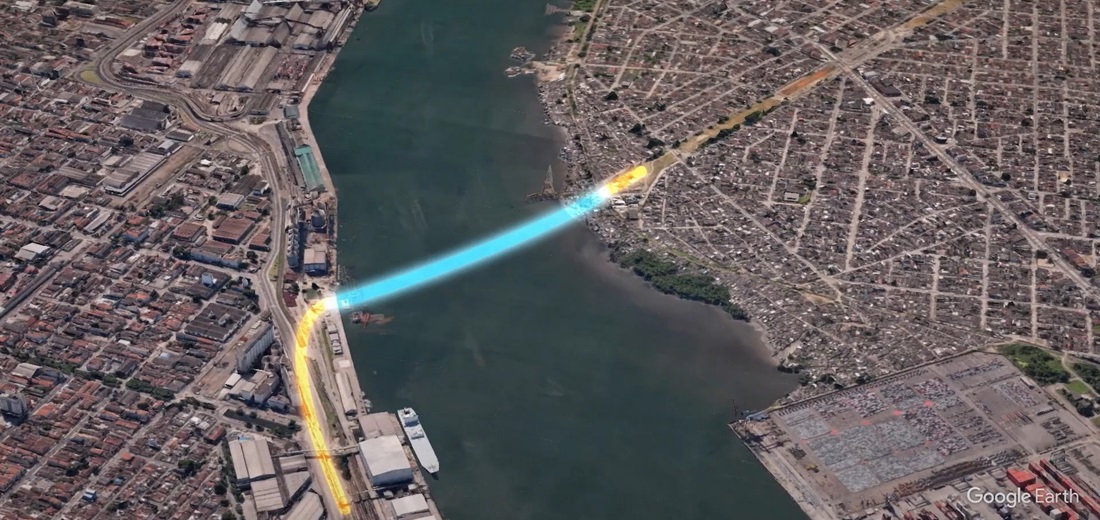
Environmental Study Required for Santos-Guarujá Tunnel Construction to Mitigate Contaminant Risks
Jul, 08, 2024 Posted by Gabriel MalheirosWeek 202427
The construction of the underwater tunnel between Santos and Guarujá will require new environmental licensing, which will involve further data collection studies on the port’s channel, building on investigations conducted more than a decade ago. The Environmental Company of the State of São Paulo (Cetesb) announced this.
The licensing process includes studies on the sediments before dredging begins for tunnel construction. “Dredging must be preceded by the analysis of the material and the proposal of control measures so that there is no release of contaminants,” explained Cetesb.
The destination of the dredged material will be determined after the analysis results are available. However, Cetesb has already indicated a potential approach: “Generally, the dredged material for the operation of the Port of Santos is destined for the Ocean Disposal Polygon (PDO), located 12 kilometers from the coast.”
Chemical engineer Élio Lopes emphasized that the study must comply with Resolution 454 of the National Environmental Council (Conama). This document establishes general guidelines and reference procedures for managing dredged material in national waters.
The Santos Port Authority (APS) stated in a note that the engineering alternatives for constructing the Santos-Guarujá tunnel, along with the necessary environmental licenses, will be defined during the preparation of the executive project.
Construction Phases
The first of the nine planned construction stages involves preparing the seabed. A trench will be dredged to lay concrete slabs, creating a level foundation for the tunnel modules. According to APS, this trenching will take 14 months without interrupting the navigation channel. The modules will be installed 21 meters below the waterline.
According to APS’s schedule, the project is currently in the legal modeling phase for the proposed public-private partnership (PPP). Three public hearings and an online public consultation were held between April 18th and 19th. The notice is expected to be published in March next year, with bidding in July.
Licensing and Approval
Work on the Santos-Guarujá tunnel, beginning with soil surveys, depends on Cetesb issuing a preliminary environmental license (LP). First, however, the State Environmental Council (Consema) must review and approve the project.
On June 12, at Palácio dos Bandeirantes in the state capital, Governor Tarcísio de Freitas and Santos Mayor Rogério Santos held a meeting. The goal is to file the environmental impact study with Cetesb soon, aiming for LP issuance before the end of the year.
The plan is to open the bidding process with LP before the end of the year to attract investors through legal certainty. Governor de Freitas assured that the contract for the Santos-Guarujá tunnel works will be signed in 2025.
The tunnel, valued at R$6 billion, will be a partnership between the State and Federal governments. The dry connection between Santos and Guarujá has been included in state management plans since February 2023, when the project was qualified for the São Paulo Investment Partnership Program (PPI-SP). The total length of the dry connection in Baixada Santista will be 1.5 km, including an 870-meter immersed tunnel beneath the port channel.
Source: A Tribuna
Click here to access this story’s original rendition in Portuguese: https://www.atribuna.com.br/noticias/portomar/construc-o-do-tunel-santos-guaruja-tera-estudo-para-evitar-liberac-o-de-contaminantes-1.425778
-
Other Logistics
Jan, 17, 2023
0
Lula’s changes at Brazil farm ministry draw cries from food security agency
-
Ports and Terminals
Jul, 30, 2024
0
366-meter supership docks in Suape for the first time
-
Grains
Jun, 23, 2022
0
Fuel crisis: rural producers join strike in Argentina
-
Fruit
Feb, 27, 2025
0
Chile to start shipping frozen fruit to Indonesia

